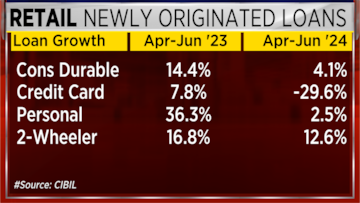Kumar noted an 11% increase in payment delays at private banks, particularly on unsecured loans and credit cards.
However, overall retail asset quality remains stable, with improvements seen in auto, home and two-wheeler loans.
Kumar also noted that the share of new customers applying for credit has declined from 12-18% to 6%, reflecting a more cautious stance on the part of lenders.
He spoke to CNBC-TV18 about how the recent policy changes by the Reserve Bank of India (RBI) are affecting the asset quality of financial firms.
These are verbatim excerpts from the interview.
Q: In January, you all came out with a report, Credit Information Bureau (India) Limited (CIBIL), which clearly showed that both the quantity and quality of retail assets were deteriorating a bit, with the quantity declining due to the Reserve Bank of India’s risk weights. How has the performance been in the first six months? Has the quantity of retail loans and more importantly the quality declined further?
A: Absolutely. First of all, in November last year, the Reserve Bank of India (RBI) made very forceful interventions for all the known reasons. That led to some changes in the product mix on the lending side – and I’m going to use the word moderation in some segments – and overall, a slightly more conservative or cautious approach. But there are a couple of factors at play here: a) the policy changes by the Reserve Bank of India, which are very timely and proactive, and b) the existing credit-deposit ratio, which is still quite high. So, when the ratio is high and the incremental cost of deposits is higher, it obviously means that you are looking at the product mix in terms of the desired targets on the net interest margin versus the cost of credit.
So almost all lenders are rewriting their product mix and capital allocation for products. So, all of that leads to some of the changes that we are talking about in terms of some change in growth rates at the product level; and more importantly, some people often ask, is there a decline in retail loan portfolios etc.? So, the answer to that is that the growth rates are pretty much intact, intact in the sense that we are still growing, India has a lot of headroom to grow. So, we are growing quite a bit. It is just that the growth rates have moderated. For example, if a product was growing at 30%, it would have moderated to 20% or 10% and the biggest decline is in unsecured loans below 10%. ₹50,000 and credit cards too.
Read also: SBFC Finance’s Aseem Dhru flags concerns over retail loan quality
Another important point is that when we talk about growth generation, it is also important to look at the trend in terms of quarter-over-quarter (QoQ) or the same quarter of the previous year – what is the growth rate like? This is very important because it sets a direction. I say this also from a risk perspective because invariably the delinquency ratios are a function of how the numerator, i.e. the new delinquencies, is produced compared to the size of the incremental portfolio. So, as the growth rates of the last quarter are steeper or lower, lower than those of the previous quarters, then the growth rate of the overall industry retail portfolio will go down. It is still growing, but the growth rate will go down.
Q: What about quality? I guess that is the biggest fear. Retail is still the go-to business. I have not yet heard any banker trying to praise corporate credit. It is a very crowded space – non-banking financial companies (NBFCs), banks, peer-to-peer (P2P) lenders, fintechs – everyone is in retail. So are you seeing, in the last six months, a further deterioration in asset quality?
A: Not really. We have good news despite all this. Last year we talked about some tension in very small amount personal loans etc. But as I said, timely interventions have brought about good control in that area. Some of the NPLs are even improving. So first of all, overall, in the retail portfolio of the sector there is good stability. If we take car loans, home loans, two-wheeler loans, all these products. There is even an improvement in overall NPLs, to start with the figures for the last quarter – a) and b) in unsecured consumer durable loans and credit cards, it is almost the same or there is a marginal increase in NPLs.

But when I talk about a marginal increase in NPLs in some of these consumer products, you have to take into account, together, two factors. One is that we had severe heat waves in April and May, which affected the efficiency of collections. And second, you have to remember also the previous point that in these products, the growth of new products is slowing down the growth rate. So, to that extent, the NPL ratios will also be a little bit higher because we now have a situation where for two or three quarters, the growth rate of NPLs or the numerator will be higher than the relative growth rate of the portfolio size. So, in one or three quarters, we will see that normalization process.
For more details, see the attached video.
Disclaimer:
The information contained in this post is for general information purposes only. We make no representations or warranties of any kind, express or implied, about the completeness, accuracy, reliability, suitability or availability with respect to the website or the information, products, services, or related graphics contained on the post for any purpose.
We respect the intellectual property rights of content creators. If you are the owner of any material featured on our website and have concerns about its use, please contact us. We are committed to addressing any copyright issues promptly and will remove any material within 2 days of receiving a request from the rightful owner.

